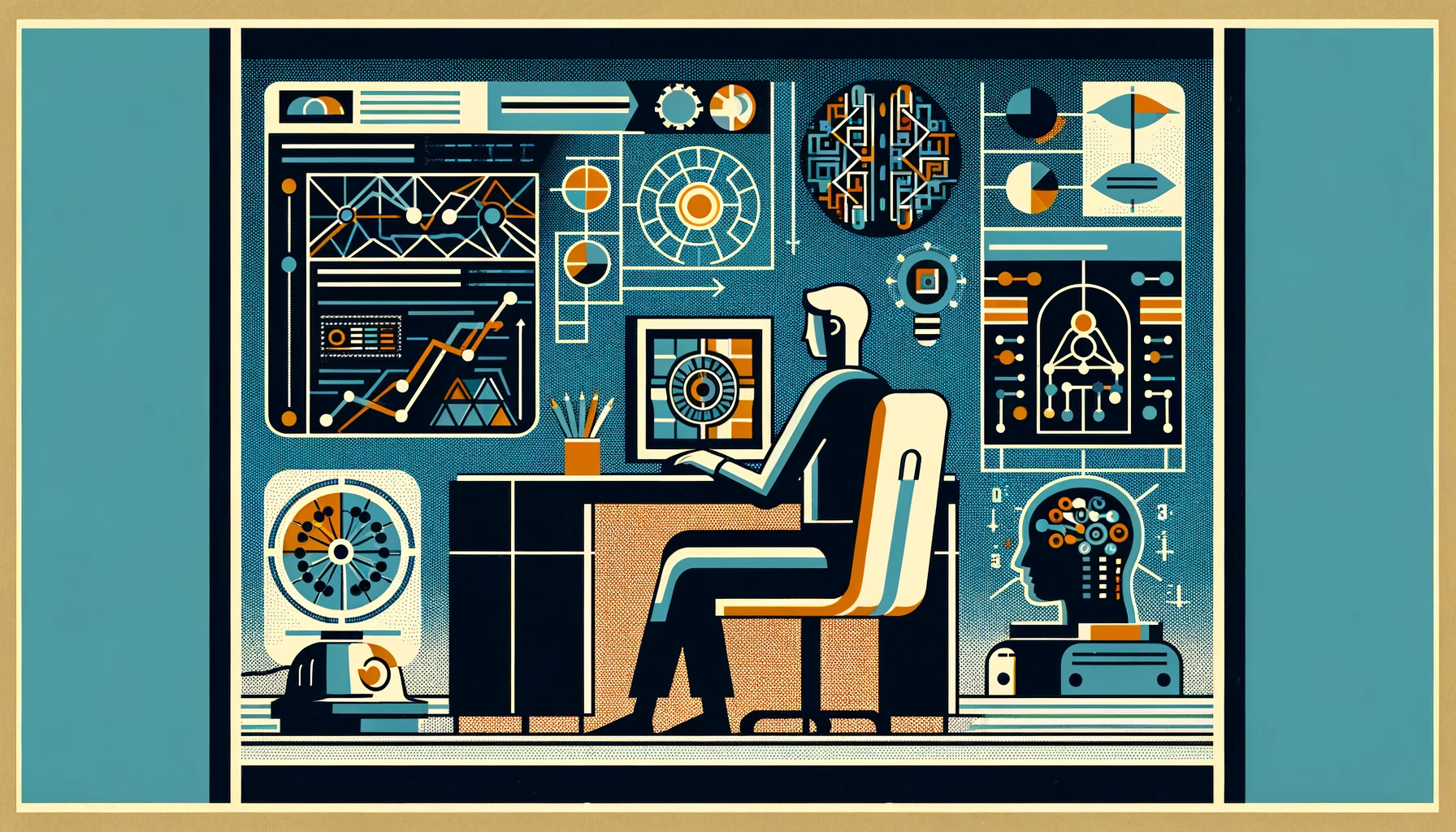By Cardiff Garcia, John Lettieri, and Adam Ozimek
Executive summary
The 2024 presidential election has featured a fierce debate over the interests of working Americans. But what do workers actually think — about their jobs, their careers, the wider labor market, and how various issues might help or hurt their well-being?
A new survey finds that the vast majority of workers in the United States are satisfied with their jobs and careers — a satisfaction that is shared almost equally between workers who plan to vote for Donald Trump and those who support Kamala Harris. They furthermore haven’t lost faith in the value of hard work as a means to get ahead in this country.
Workers remain deeply anxious, however, about the rising prices of things they need, and they lack confidence in the opportunities available in the labor market. What they most want from their jobs — more than better benefits or flexible schedules or longer vacations — is higher pay. What they most want from the economy is lower costs. They are also profoundly dissatisfied with the country’s political leaders, whom workers believe are a major impediment to the life they want to achieve.
These findings are from a national survey of 1,516 respondents conducted by Echelon Insights for the Economic Innovation Group (EIG) from September 6-11. Uniquely, the survey focuses on the views of American workers — people who are employed or actively looking for work — rather than the wider American electorate.
What it reveals is a labor force that is strikingly optimistic about technological change, divided on the hot-button issue of immigration, unafraid of trade, and cautiously positive about the role of labor unions as a force for good. Furthermore, when asked to choose, workers in both parties preferred low taxes and light regulation as the best way to help American workers over placing tariffs on imports or helping workers join a union.
The survey is an extension of EIG’s American Worker Project, an exploration of how well the US economy has fundamentally delivered for the typical worker in recent decades.
To see all the detailed findings — including the views of college-educated vs non-college workers, how men and women experience work differently, the relationship between income and workers’ economic outlooks, and their stances on globalization and labor unions — in addition to the survey’s methodology, open the full presentation below:
Satisfied at work, but pay and price worries linger
Seventy-one percent of workers say they are either somewhat satisfied or very satisfied with their current job, versus just 15 percent dissatisfied.
The share of workers at least somewhat satisfied with their overall careers is also high, at 64 percent. Only 17 percent say they are at least somewhat dissatisfied, a 47 percentage-point difference.
Just one in 20 workers is very dissatisfied, outnumbered by more than six to one by those who rate themselves as very satisfied.
A smaller difference — though one that still reflects the satisfied majority — exists between workers who are satisfied with how much money they make at this stage in their career and those who are not.
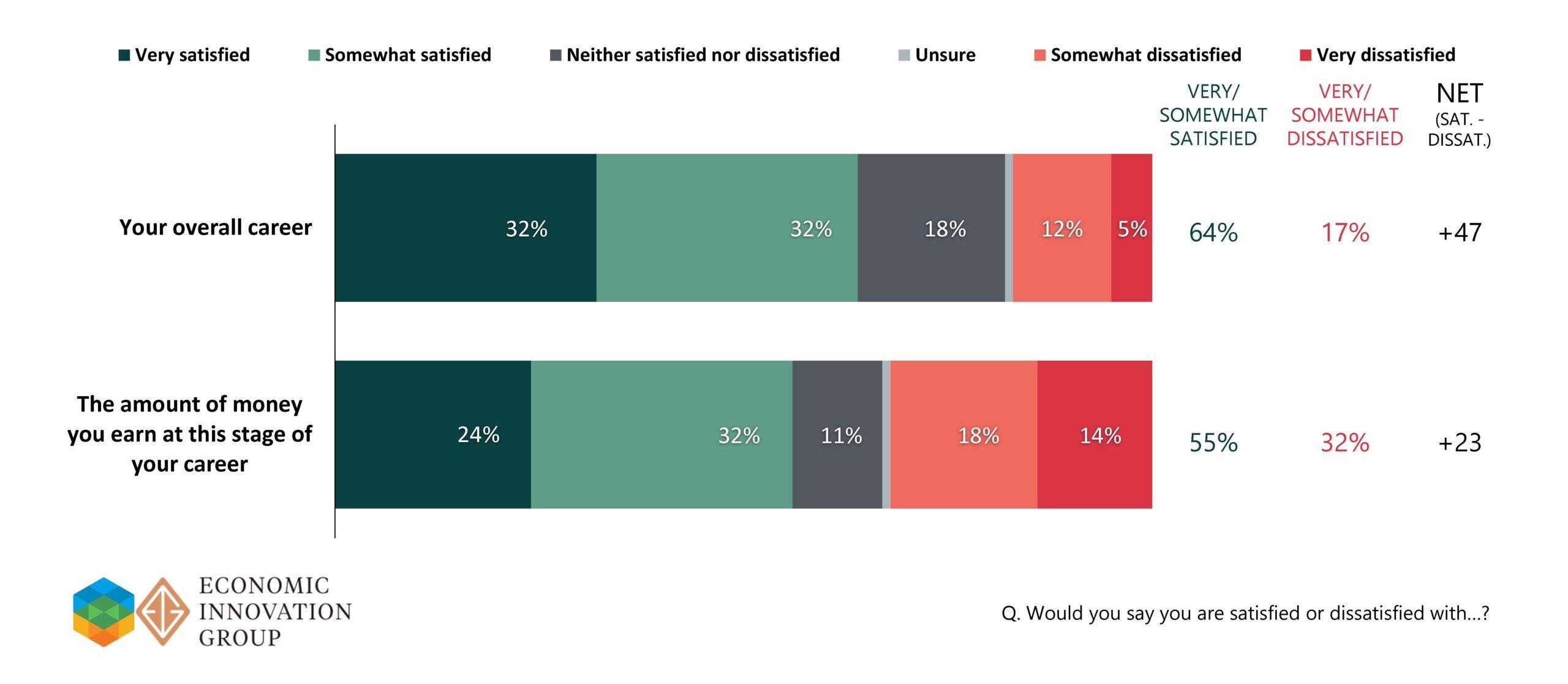
Not only are most workers satisfied with their jobs and careers, they also retain a sturdy belief in (one version of) the American dream. A solid majority — 70 percent — agree with the statement: “If you work hard, you can succeed in America today.” More than three-quarters of workers with a college degree have this belief, but it is also shared by 65 percent of non-college workers.
Contentment with their work extends into various parts of workers’ jobs and careers. Overwhelming majorities of workers are satisfied with their current job security, the amount of personal time available to them outside of work, and how hard they work.
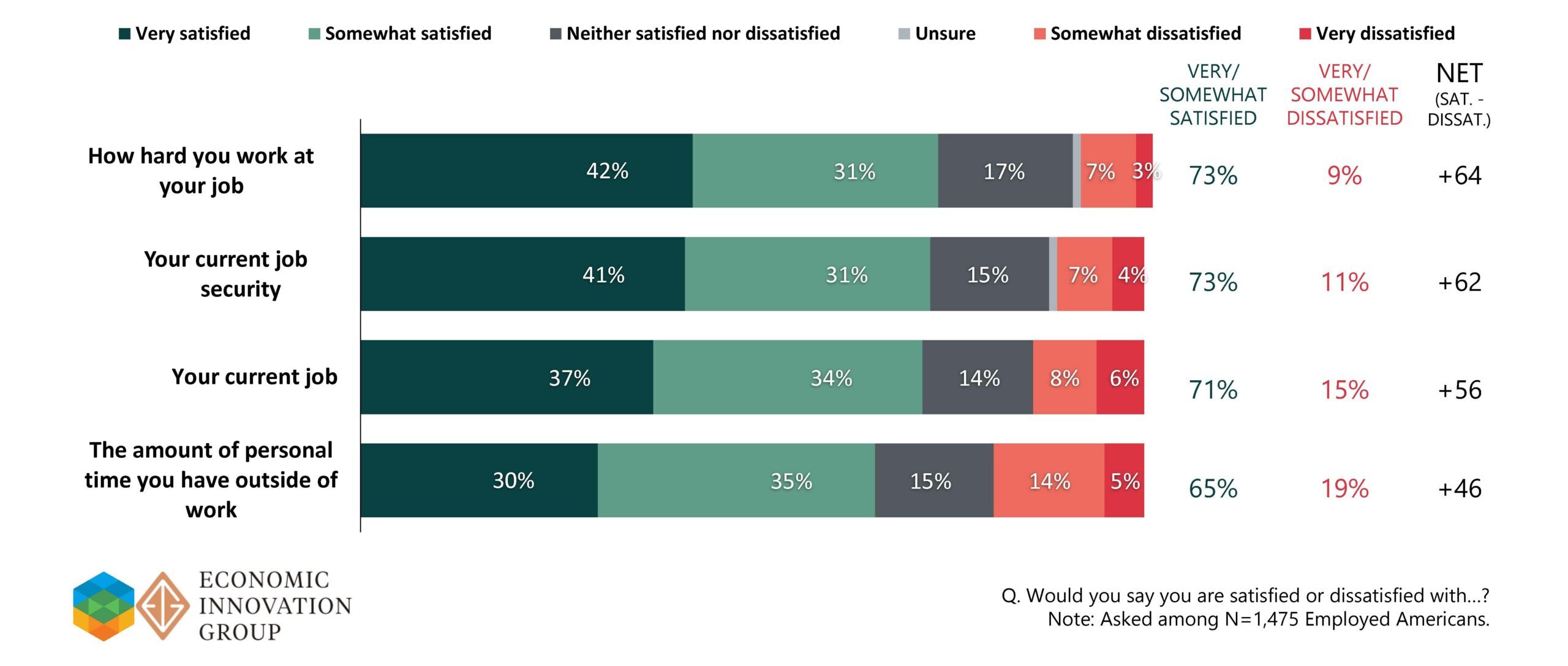
More than four out of five workers believe they are using their talents and skills at their current job, and nearly as many find their work interesting and engaging. Almost 70 percent of workers also agree that their job provides them with “opportunities to grow as a person and professional”.
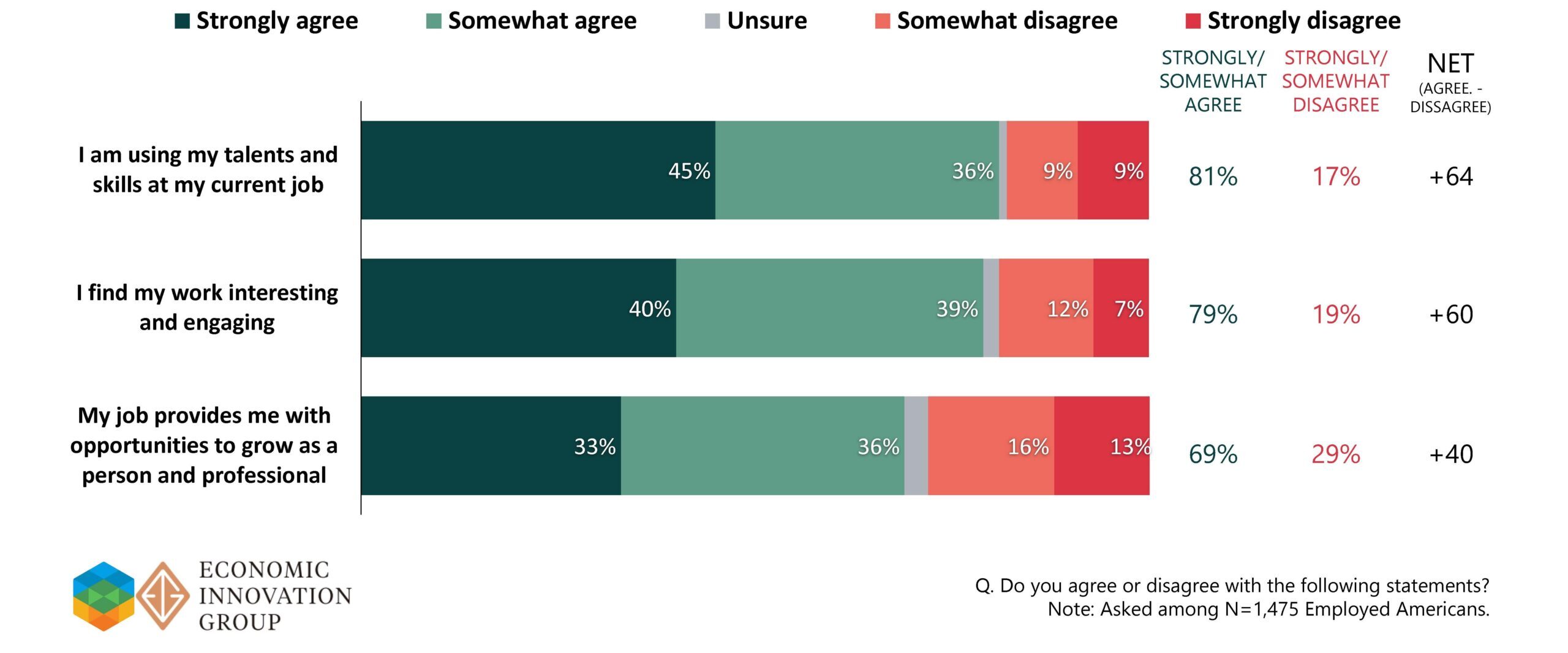
More than seven out of 10 workers are at least somewhat confident in their ability to meet their short-term and long-term financial goals. More than three-fourths of workers are confident in their ability to live a middle-class or better lifestyle, and to achieve the life they desire as long as they work hard. Almost nine out of ten are confident in their current ability to cope with work-related stress.
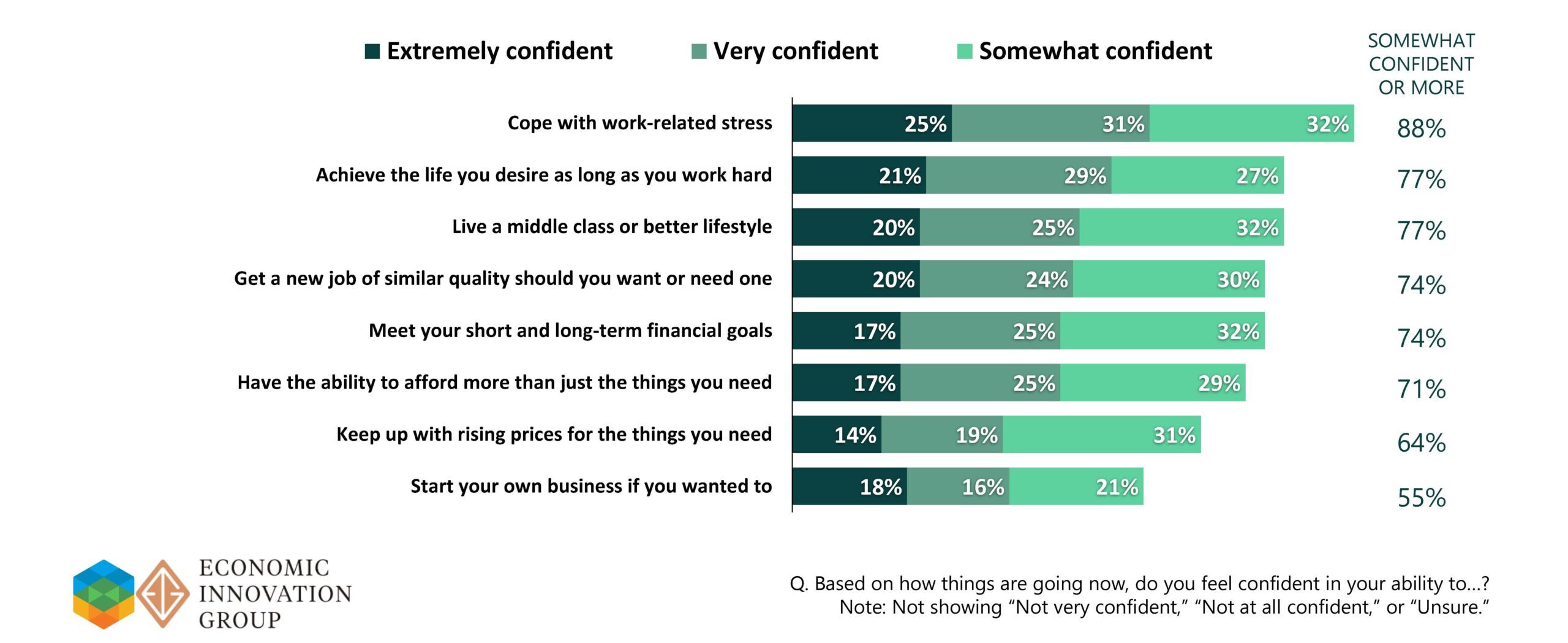
Pay, prices, and opportunity
Asked what they would choose if they could make one change to their current work situation, 55 percent of workers said they would opt for a higher salary. All other proposed changes combined were chosen by just 38 percent of workers, with 7 percent saying they would not make any changes.
A split emerged between workers with different educational attainments. Six in 10 workers without a college degree chose a higher salary, against just 47 percent of college-educated workers.

Although 73 percent of workers report being satisfied with their job security, nearly half (47 percent) say that it is very hard or somewhat hard for them personally to find “a good job with good pay”, while only a third say it is easy or somewhat easy.
Consistent with other surveys, workers also have a tendency to say it is easier for themselves to find these jobs than for others in their communities or throughout the country.
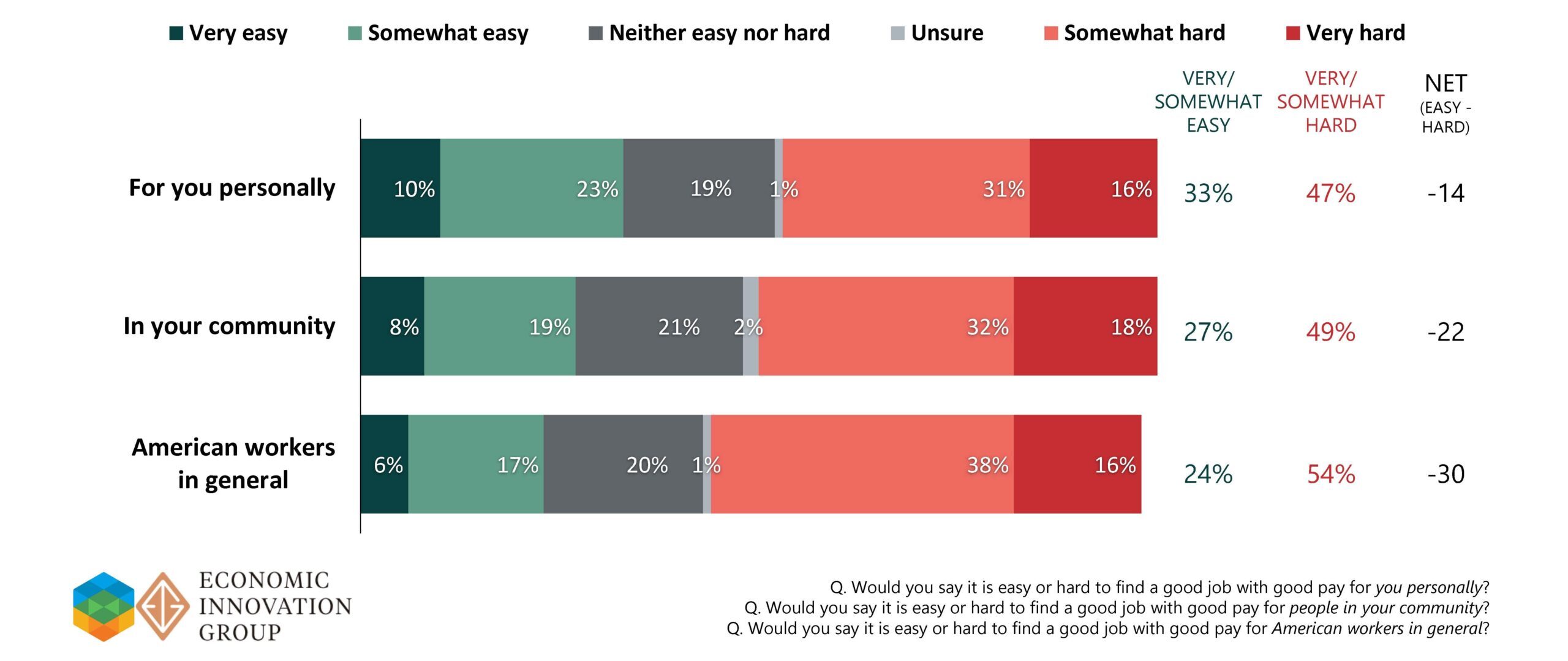
Of all the options tested, by far the biggest decline in confidence compared to before the pandemic was related to workers’ ability to keep up with rising prices for things they need. A plurality of 44 percent — including fully half of non-college respondents — say they are less confident they can keep up with prices than before the pandemic, 16 percentage points higher than the share who say they are more confident.
The costs of products, services, and housing are the dominant sources of financial stress, totalling a combined 45 percent of workers, followed by 13 percent of workers who rate an underpaying job as their top concern.
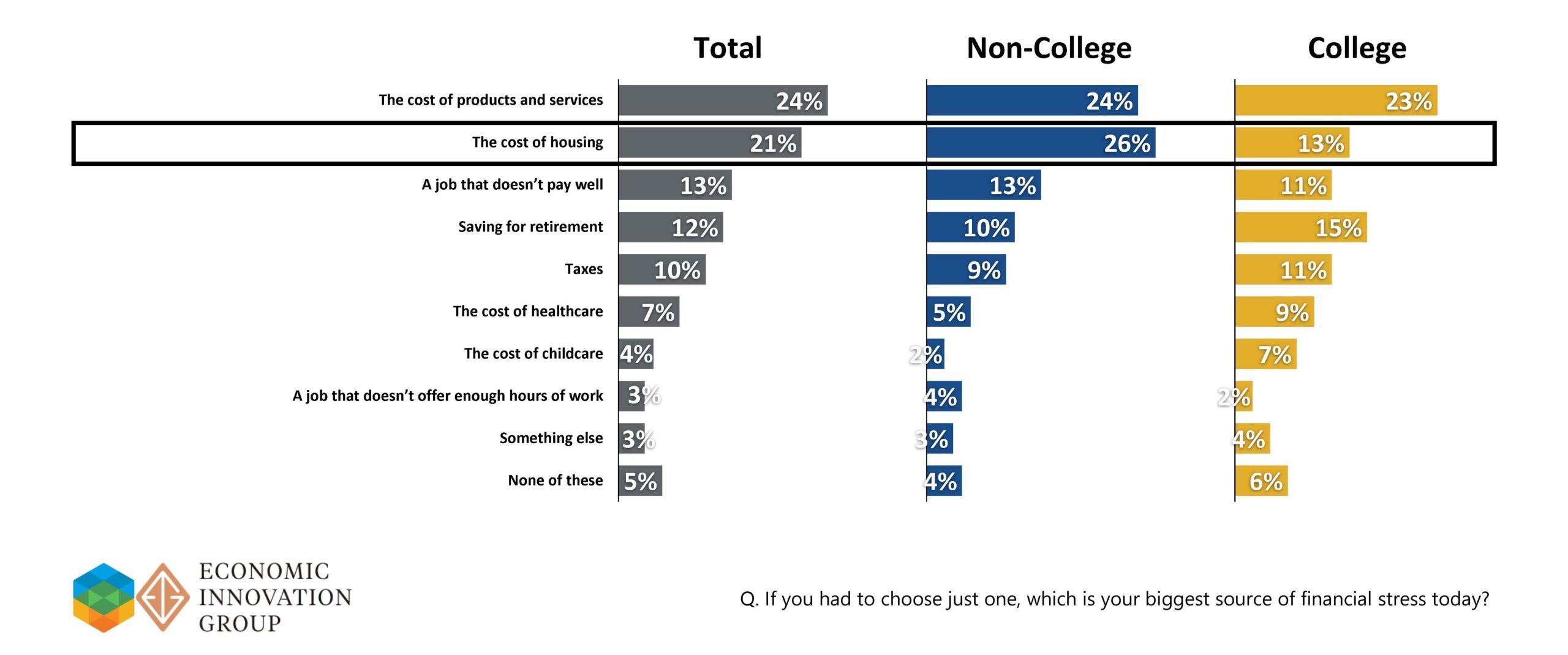
Working voters: Trump vs Harris
Who they are
More than half of Trump voters in the workforce — 53 percent — define themselves as blue collar or service workers, while only 41 percent of Harris voters do. Harris voters are more likely to be white collar and college educated, with 47 percent of them having degrees versus 39 percent of Trump-voting workers.
Trump-voting workers are also more likely to live in small towns or rural places than Harris voters, at 24 percent to 16 percent respectively.
While workers who support Harris are evenly split between the two genders, nearly six in 10 workers who will vote for Trump are male.
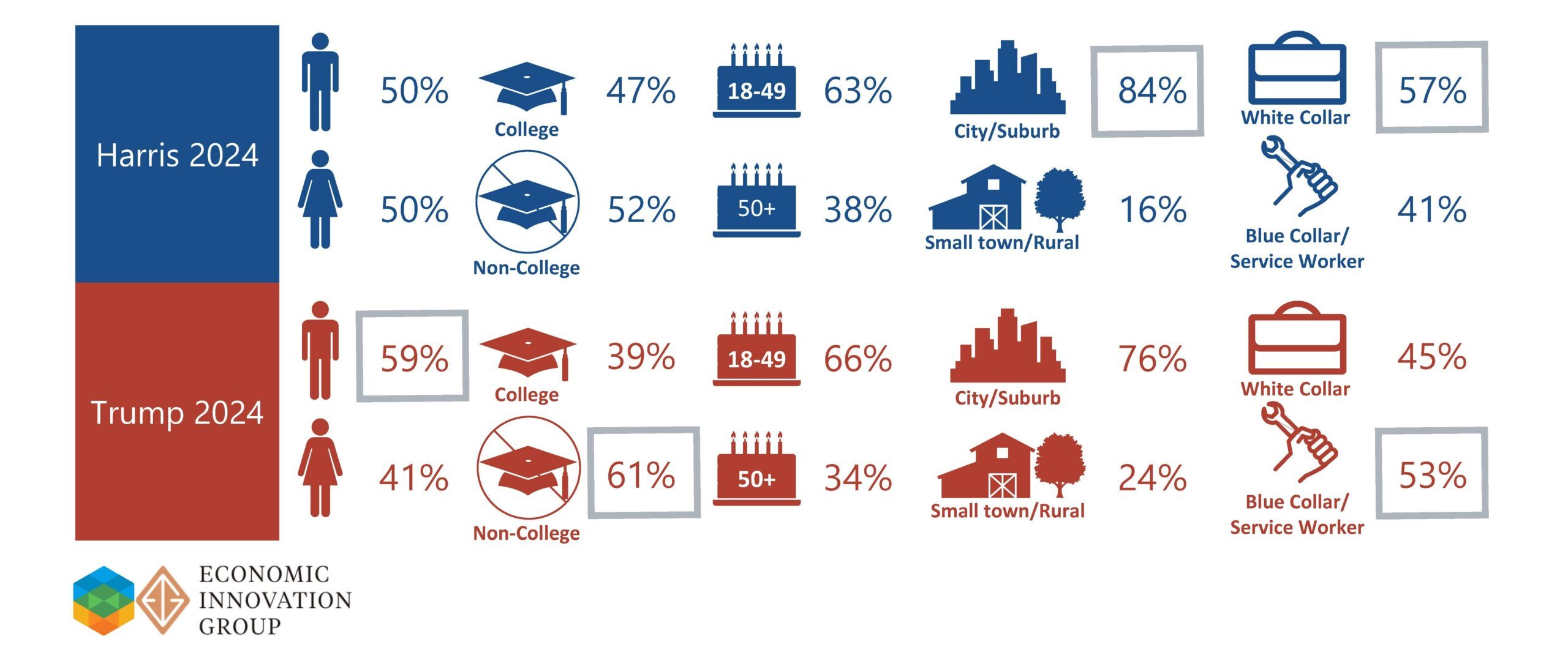
Similar satisfaction, different priorities and outlook
Trump voters in the workforce are only slightly more likely to be satisfied with their overall careers (68 percent) than Harris voters (65 percent).
An almost identical share of Trump voters and Harris voters surveyed also say it is very hard or somewhat hard for them personally to find good jobs with good pay (46 and 45 percent respectively).
The biggest source of financial stress for supporters of both candidates is higher costs. Only 30 percent of Trump voters say they are very confident or extremely confident in their ability to keep up with rising prices of necessities, versus 38 percent for Harris.
But the prices they most worry about differ. Harris-voting workers are more likely than workers who support Trump to emphasize housing costs as their biggest financial stressor. Trump voters are more likely to identify the costs of products and services or a job that doesn’t pay well.
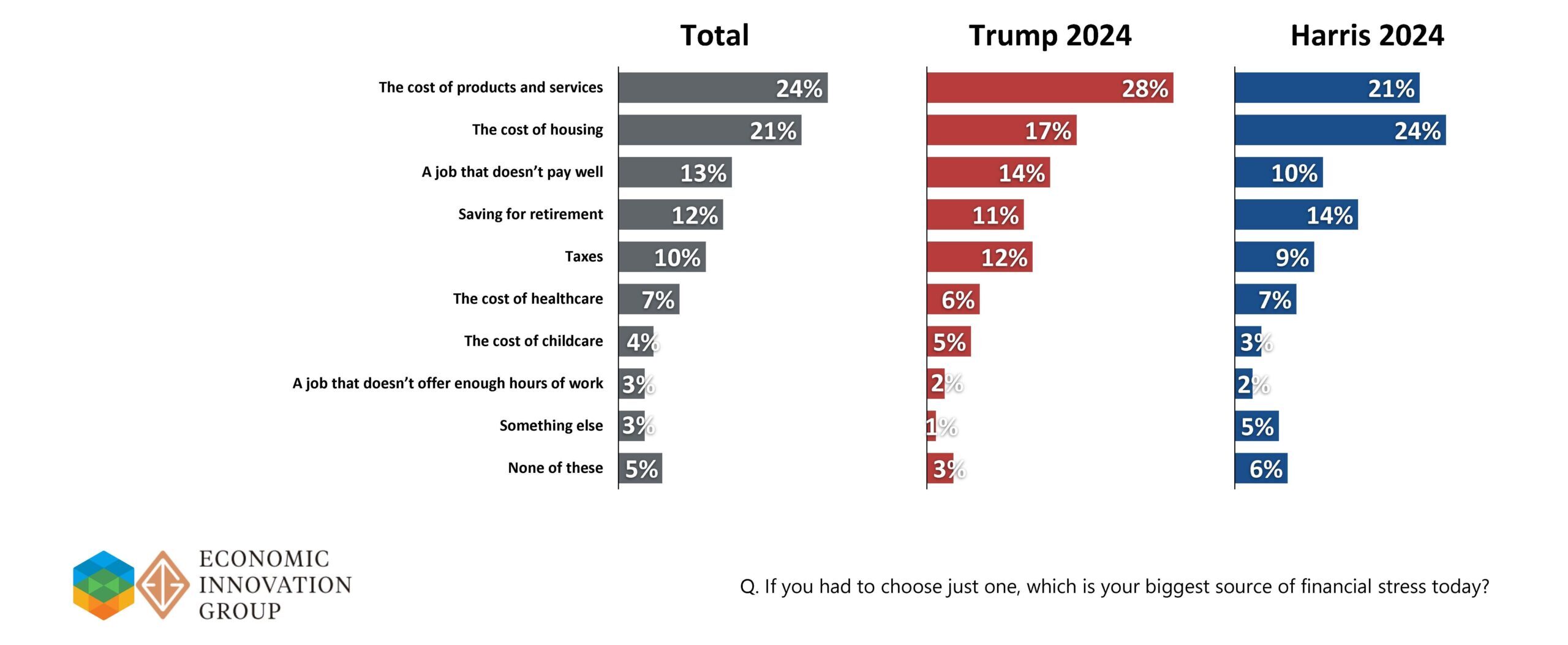
Parties, platforms, perceptions
At 63 percent, a much higher share of Trump voters say they would be more likely to achieve the life they desire if only the country had different national political leaders. But even the 44 percent of Harris voters who agree represents a plurality of her working supporters, suggesting widespread political disillusionment.
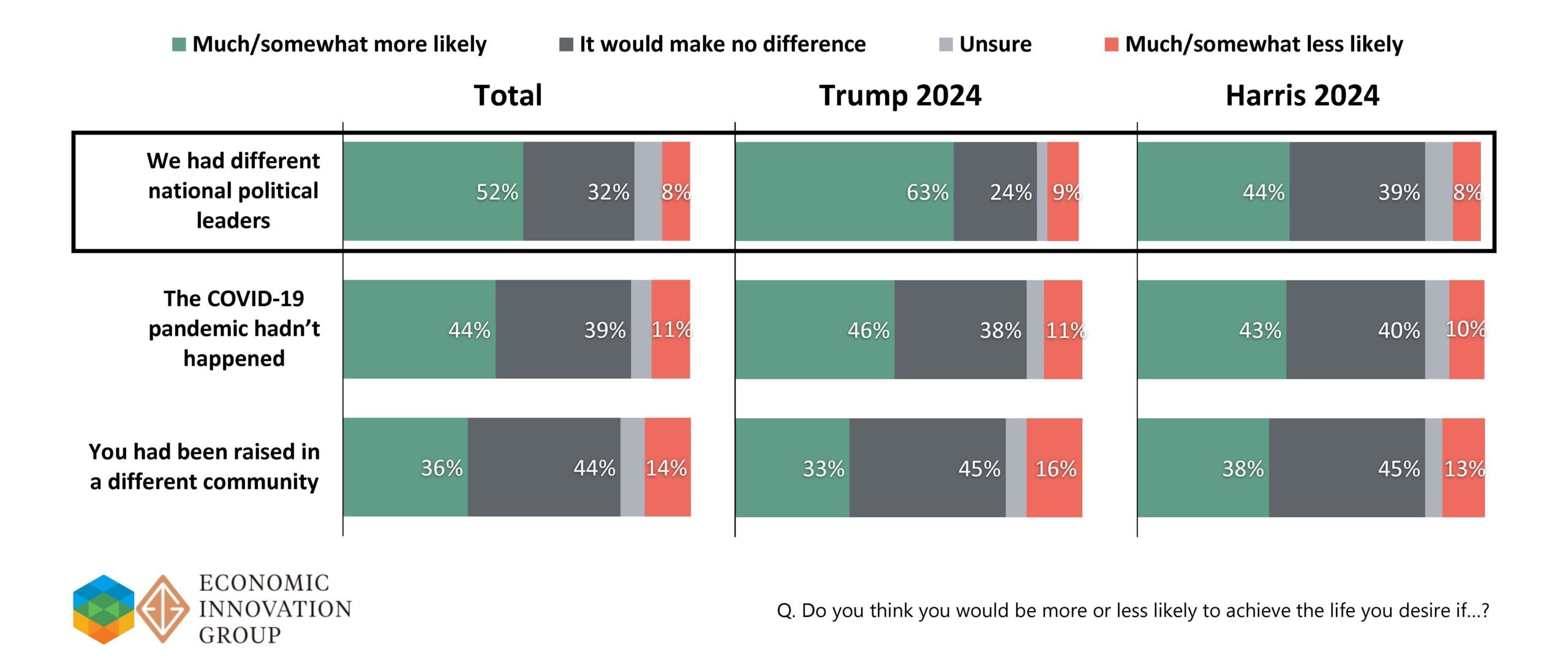
Workers are more likely to say the Democratic party is better for their interests than the Republican party, while more workers think the Republicans have a better approach to immigration. Workers view the parties almost equally on the issues of taxes, cost of living, and trade with other countries.
On these same issues, however, a large degree of political polarization did reveal itself between college and non-college workers.
Workers with a college degree are more likely to say Democrats are better on taxes, cost of living, and trade — while non-college workers believe the Republicans have the better approach to those issues.
Democrats are still the preferred party for advancing worker interests, but by much bigger margins among college-educated workers. The Republican Party is similarly also seen as better on immigration by workers of both education levels, but with a more decisive majority among non-college workers.
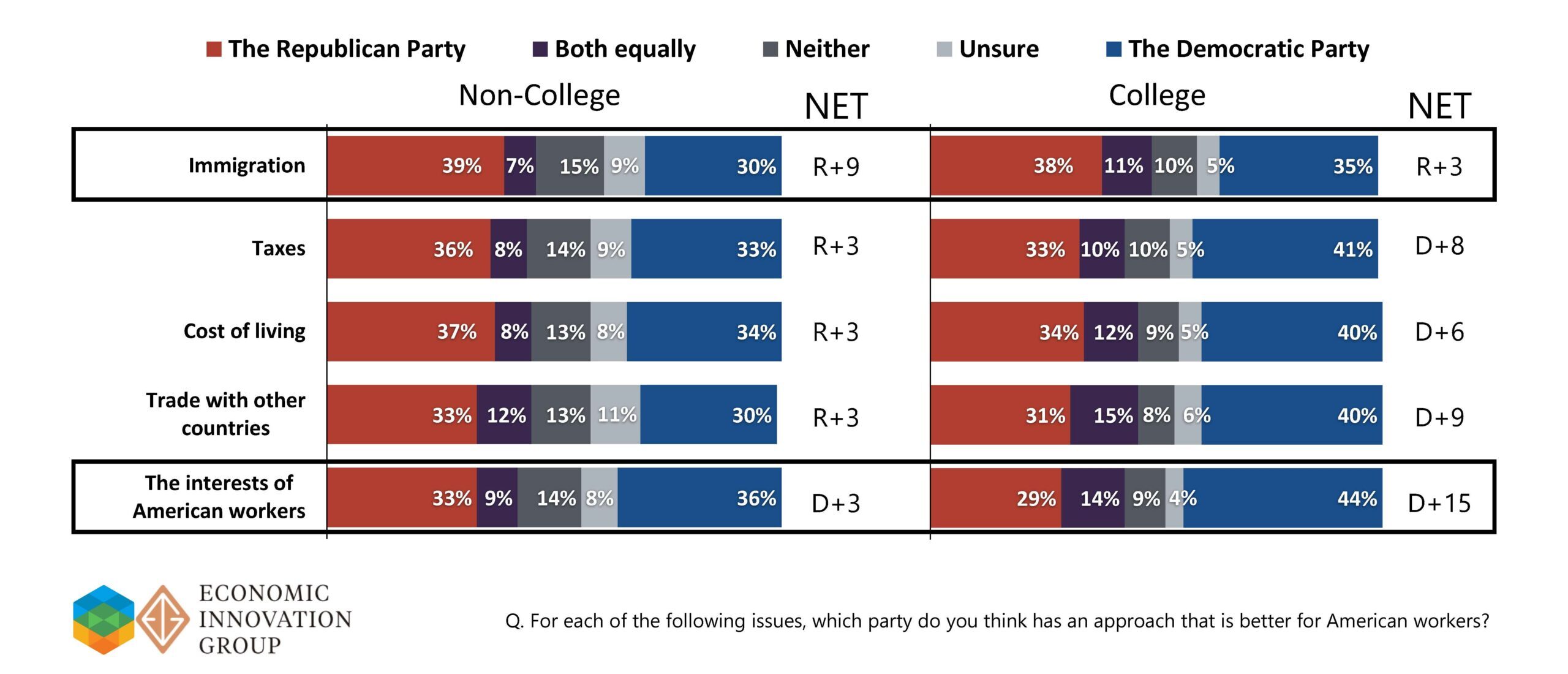
Among the starkest differences between Trump and Harris supporters in the workforce is their attitudes towards labor unions. While 64 percent of Harris voters believe that labor unions are a net positive for American workers, just 40 percent of Trump voters agree. One in five Trump voters believes unions to be net negative, while just one in 14 Harris voters says this. (The remainder believe unions are neither positive nor negative.)

Perhaps counterintuitively, support for unions in general was driven by workers with higher levels of educational attainment. Non-college workers (48 percent) are less likely than college graduates (56 percent) to say unions are a net positive. Furthermore, self-described blue collar workers are the most likely to believe that unions are a net negative, at 20 percent.
Finally, surveyed Trump and Harris supporters perceive different threats and opportunities to their careers.
More than 60 percent of Trump supporters believe illegal immigration is probably or definitely a threat, nearly double the share of Harris supporters. The share of Trump supporters who say that foreign imports are a threat is smaller, at 35 percent, though still more than twice the Harris share of 17 percent.
Workers who support both candidates are more likely to say that legal immigration is an opportunity rather than a threat.
And in their biggest source of agreement, more than 60 percent of both Harris and Trump supporters believe that new technologies are an opportunity.
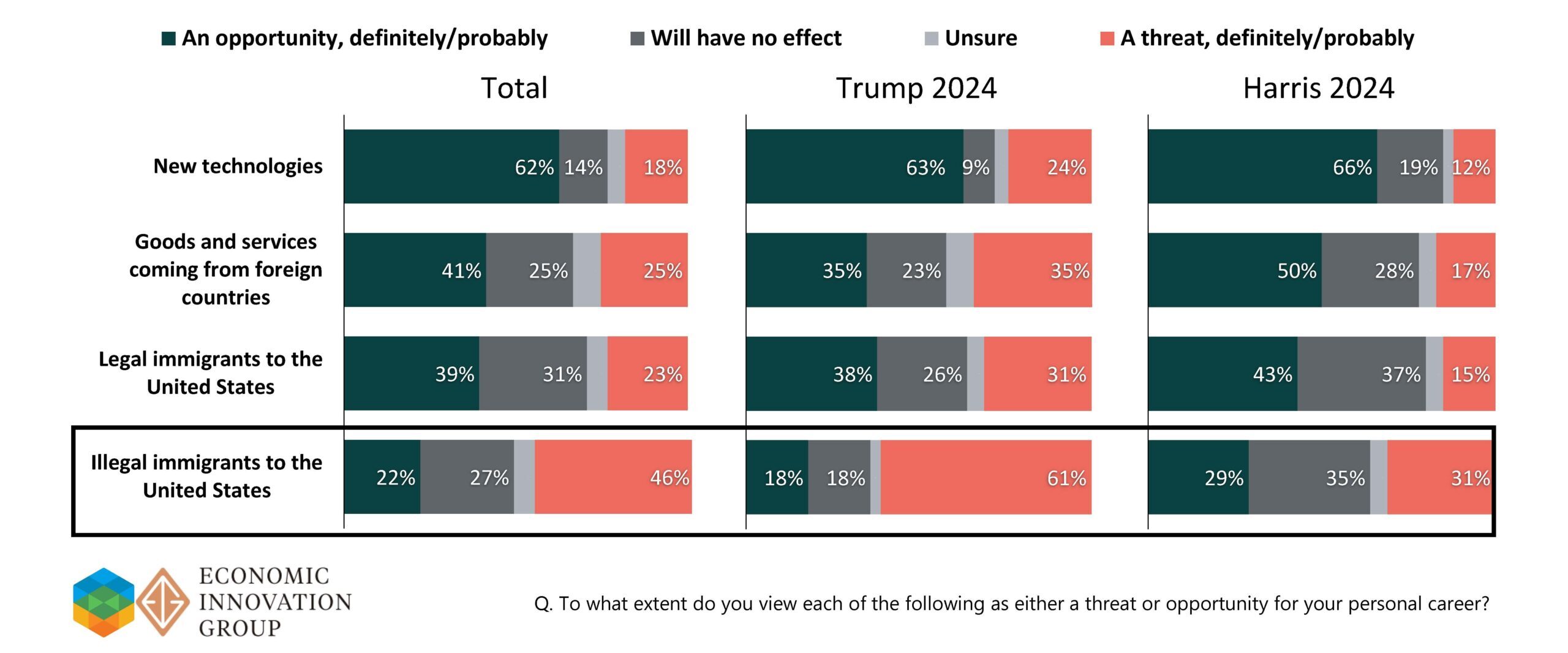
Once again there are meaningful differences between workers of differing educational attainments — for supporters of both candidates. Non-college voters are more likely than college voters to see new technologies, imports, and both legal and illegal immigration as threats.
Broken down further by candidate preference, college and non-college supporters of both Trump and Harris all are more likely to say — by a wide margin — that new technologies are an opportunity rather than a threat, with the largest embrace from college-educated Harris voters.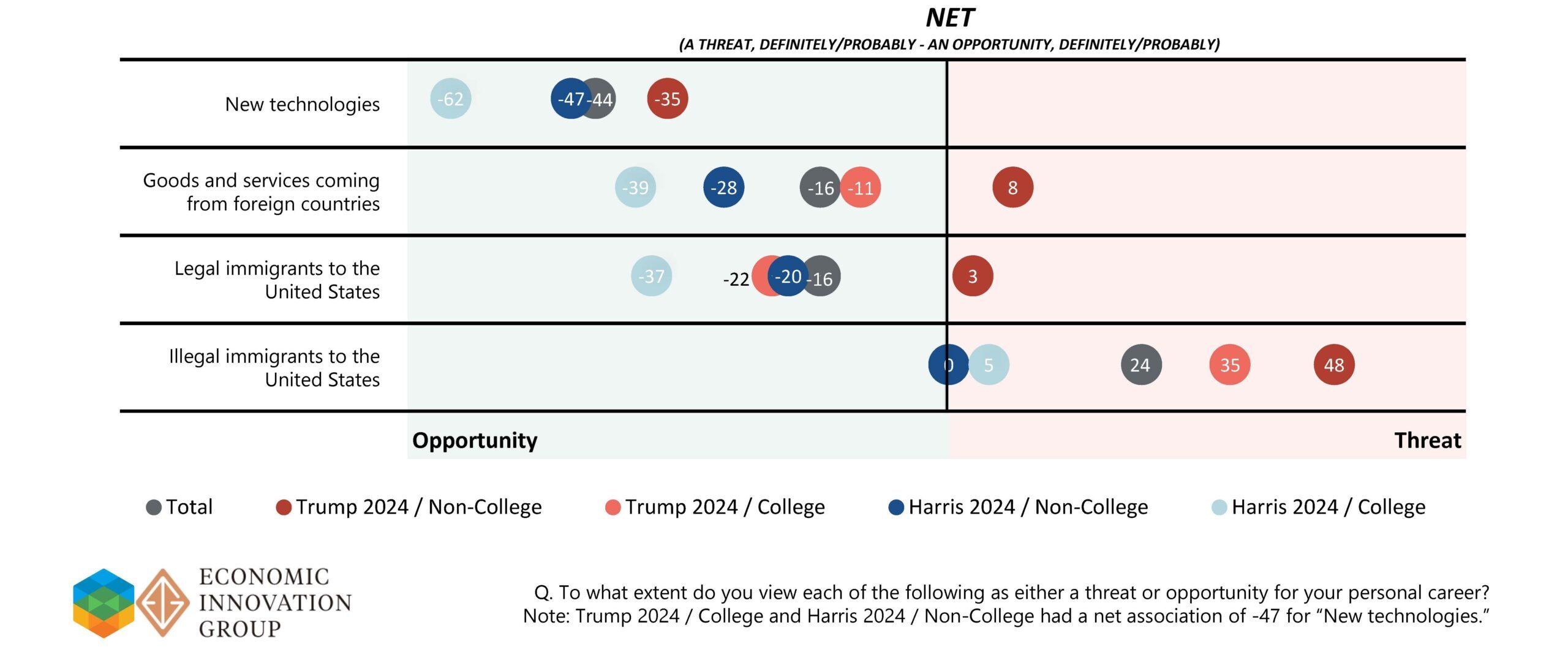
Non-college Trump voters represent the only category of workers not to see trade and legal immigration as opportunities on net. They are also the least likely to see any of these trends as opportunities.
Policy preferences
We wanted to understand how workers think about the relative merits of three potential policy avenues for advancing worker interests: low taxes and deregulation, tariffs on imports, and broader union membership. The survey presented respondents with three head-to-head scenarios and asked them to pick the statements that most closely reflected their views.
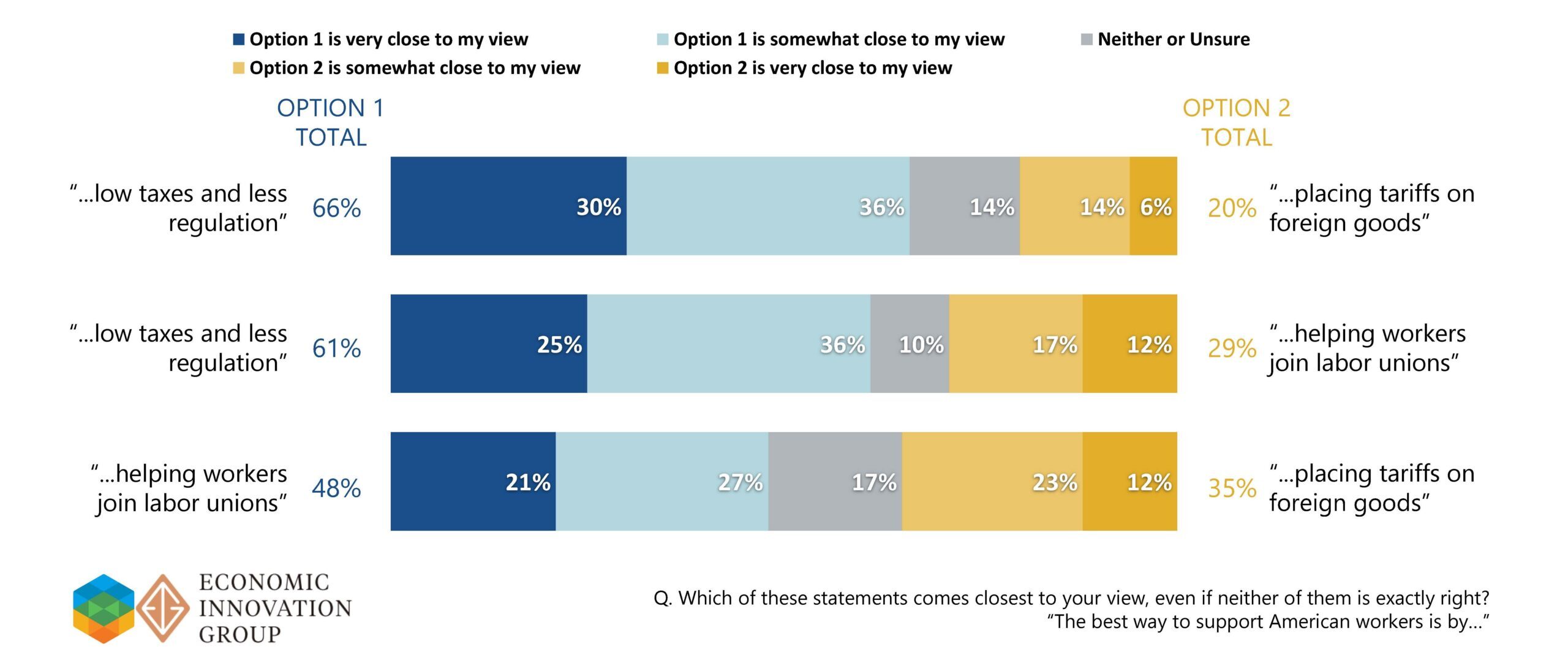
Of these three options, “low tax taxes and less regulation” was the most popular by a wide margin among workers supporting Trump and Harris alike. “Placing tariffs on foreign goods” was the least popular option.
When pitted against “placing tariffs on foreign goods,” the low taxes and less regulation statement was very or somewhat close to the view of 66 percent of respondents, compared to only 20 percent who aligned with the pro-tariffs statement and another 14 percent who were unsure or indifferent.
Non-college workers were even more strongly aligned with the low taxes and less regulation option, favoring it by a 51-point margin, while blue collar workers favored it by a 43-point margin.
Interestingly, workers supporting Trump and workers supporting Harris both preferred low taxes and less regulation by an identical 45-point margin.
“Low taxes and less regulation” (61 percent) also heavily outperformed “helping workers join a union” (29 percent). Here, however, there was a much more pronounced partisan divide. Trump-supporting workers overwhelmingly favored low taxes and less regulation; at 73 percent (a +51 margin), it was their strongest head-to-head preference of any of the three scenarios. Meanwhile, only a slight majority (51 percent) of Harris supporters preferred low taxes and less regulation, resulting in a +13 margin over the union statement.
Consistent with our other findings, non-college workers were slightly more favorable toward low taxes and less regulation over unions (+33) than college educated workers (+28). Those with a graduate degree were the most evenly split (+14). Among self-described blue collar workers, “low taxes and less regulation” was the preferred choice by a 22 point margin.
The preference gap was smallest when workers were asked to choose between “helping workers join labor unions” (48 percent) and “placing tariffs on foreign goods” (35 percent). Here again, there was a clear partisan divide. A slight majority of Trump-supporting workers (51 percent) preferred tariffs, while a larger majority (61 percent) of Harris-supporting workers aligned with unions.
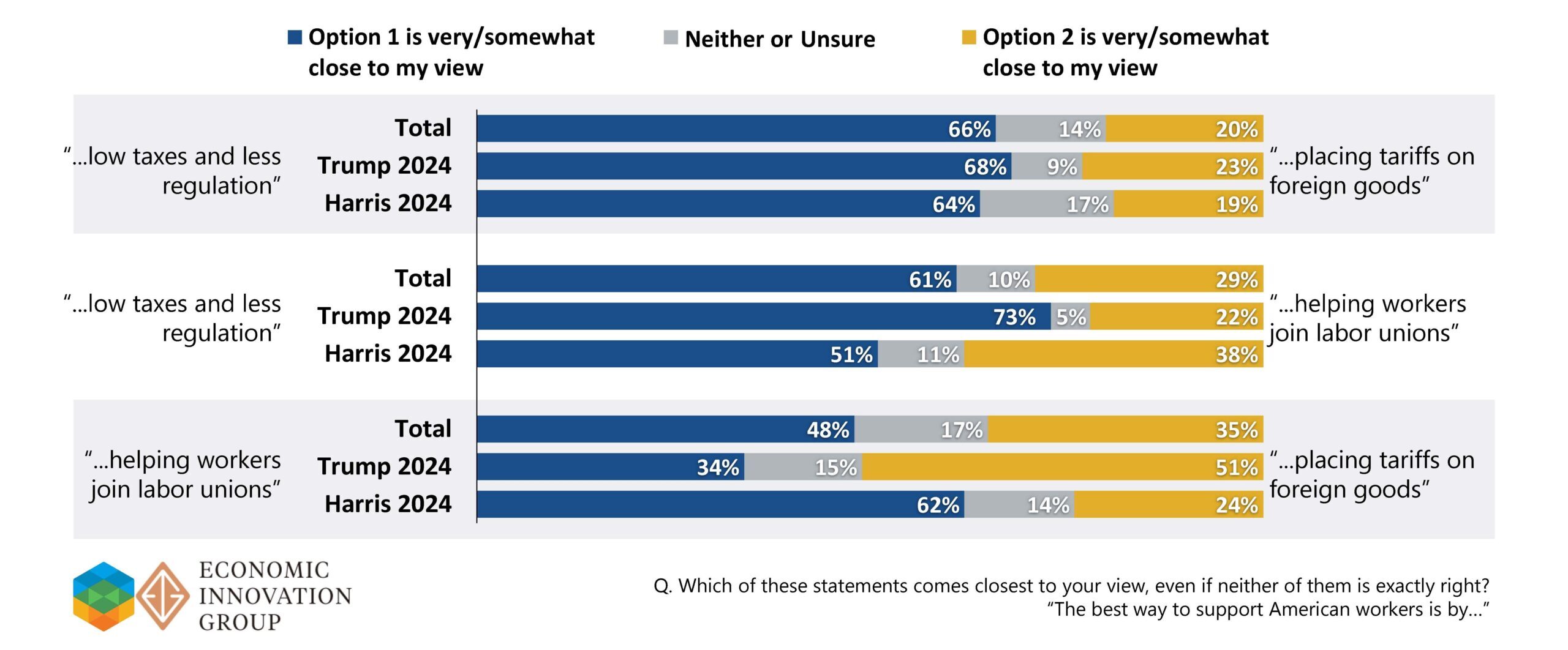
To summarize: When the policies are set against each other, workers in both parties believe low taxes and less regulation are a better way to support American workers than either placing tariffs on imports or making it easier to join labor unions. Workers who support Trump are more open to tariffs and more skeptical of unions, while the reverse is true of those who support Harris.
What do these findings mean for the winner of the 2024 elections? Plausibly, either a President Trump or a President Harris could simultaneously pursue lower taxes and deregulation, greater unionization, and higher tariffs. Both candidates have pushed a version of all three options in their campaigns, even if the details have (often quite dramatically) differed.
What the survey reveals is the relative popularity among workers and the bipartisan appeal — or lack thereof — of the policy choices. Depending on how the eventual president prioritizes each of these economic policy approaches, the findings might also therefore be a sign of how American workers will come to assess the new president’s agenda.



